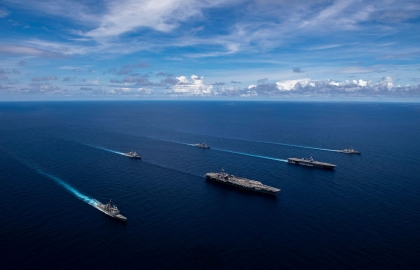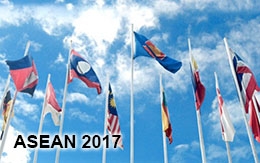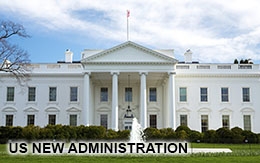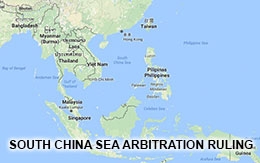The Major Powers’ Relations in the South China Sea from Chinese Perspectives
The South China Sea is one of the most important maritime communications in the world, connecting the Pacific Ocean and the Indian Ocean. About 50,000 merchant ships and nearly 50% of oil tankers of the world pass through the South China Sea every year. Under the current very complicated and turbulent international situation, if the peace and stability in the South China Sea can be maintained, the development and prosperity of East Asia-Pacific region can be realized.

The South China Sea is one of the most important maritime communications in the world, connecting the Pacific Ocean and the Indian Ocean. About 50,000 merchant ships and nearly 50% of oil tankers of the world pass through the South China Sea every year. Under the current very complicated and turbulent international situation, if the peace and stability in the South China Sea can be maintained, the development and prosperity of East Asia-Pacific region can be realized.
Main Features of Current Major Powers’ Relations in the South China Sea
1. With the superposition of internal and external factors, the situation in the South China Sea has been relatively stable in 2022.
The internal factors are as follows:
1) The Regional Comprehensive Economic Partnership (RCEP) formally entered into force in Jan.1, 2022, which is beneficial for the economic development of member states and regional stability in the South China Sea. All coastal countries and almost all stakeholders of the South China Sea are member states of the RCEP, so they would like to see the peace and stability of the South China Sea.
2) China would like to maintain the stability in the South China Sea, and has finished reclamation and islands building.
3) During the recent years, bilateral relations between China and Vietnam, China and the Philippines, China and Malaysia have been improved respectively. ASEAN countries do not like to choose a side to stand in line between China and the U. S..
The external factors are as follows:
1) The Taiwan question has become the hot spot in China-U.S. strategic competition since 2020, especially in 2022. The Trump Administration tried to bring Taiwan into the overall layout of its “Indo-Pacific Strategy”, and make use of Taiwan as its chess piece to contain China, so it changed the relatively convergent methods of the Obama Administration about Taiwan policy and U.S.-Taiwan relations into very radical ones. The Biden administration has largely continued the U.S.-Taiwan relations of The Trump Administration, manipulating the Taiwan question to push on with its“Indo-Pacific Strategy”. Even knowing the danger of the Taiwan question, Nancy Pelosi, speaker of the House of Representatives of the U. S. Congress, visited Taiwan in August 2022, causing the latest round of tension between China and the U. S.. So the Biden administration has to pay more attention on the Taiwan question instead of the South China Sea.
2) It is difficult for the Biden administration to take new hard power measures to Further restraint China in the South China Sea in 2022.
3) That Russia sends troops to Ukraine made the geopolitical and security games between the United States and Russia rapidly intensified. The Biden administration has provided Ukraine with a big mount of weapons and equipment, so it has not had enough strength to play games in the South China Sea.
2. Uncertainty and unstable factors still exist in the South China Sea.
The U.S. has regarded China as its strategic competitor since December 2017
China and the United States have entered a long-term strategic stalemate, which will last 10 to 30 years. The focus of China-U.S. strategic competition is the Asia Pacific region, especially including Taiwan Strait and the South China Sea. The Russia-Ukraine war has intensified the tension between China and the U. S.. After the outbreak of the Russia-Ukraine war, the Biden Administration has exerted great pressure on China. China has pursued an independent diplomatic strategy for peace. On one hand, China maintain a high level of strategic collaboration with Russia. On the other hand, China points out that China-Russian cooperation has a bottom line, which is the purposes and principles established in the UN Charter, and recognized international law and basic norms of international relations. China has been promoting peace talks between Russia and Ukraine, and has provided Ukraine and other affected countries with humanitarian assistance. It is is impossible for China and Russia to form an alliance, because China will continue to pursue its independent foreign policy, and Russia does not want to become ally with China due to China having not realized its reunification with Taiwan. At present, China and Russia have to cooperate because both of them are faced with serious pressure from the U.S. and its allies.
U.S. Navy continues to pursue Freedom of Navigation Operation and joint exercises in the South China Sea. Since 2015 the U.S. has pursued 39 Freedom of Navigation Operations aimed at China, 5 a year and once every 2 months on average. The scope of the actions covers China's the Xisha Islands, the Nansha Islands and Huangyan Island of the Zhongsha Islands, even entering Chinese Internal water of the Xisha Islands. At the same time, U.S. Navy performed joint maneuvers with Japan, Australia, Britain, the Philippines, New Zealand, the Netherlands, Canada in the South China Sea for more than dozens every year. Those Freedom of Navigation Operation and joint exercises have aggravated the tensions in the South China Sea.
Involvement by external powers militarily has made the situation in the South China Sea much more complicated.
Until now, about 10 external powers have been militarily involved in the South China Sea, including not only above joint military maneuvers, but also warships Irregular cruises and warship crossing of India, France, Germany and etc. Furthermore the Biden Administration have pursued the “Indo-Pacific Strategy”, mainly aiming at China. U.S. “Indo-Pacific Strategy” has tried to strengthen pressure on China by reinforcing the structures of its allies and partners. In security domain, the U.S. intensifies the bilateral alliances(with Japan, South Korea, Australia, the Philippines, and Thailand); established US-UK-Australia trilateral security partnership(AUKUS); Upgrades the US, Japan, India, and Australia quadrilateral security mechanism(QUAD); expanded the function of Five Eyes Alliance(the US, Britain, Canada, Australia, and New Zealand). U.S. “Indo-Pacific Strategy” and its alliances have had very negative impacts on the Peace and Stability of the South China Sea.
3. Coastal countries of the South China Sea have not formed the good habits of maritime cooperation.
Although those countries have already had some bilateral maritime cooperation in the South China Sea, such as China-Vietnam Navy Beibu Gulf Joint Patrol, but very few. They are usually familiar with unilateral actions in the South China Sea.
What Should the Related Countries Do to Maintain the Peace and Stability of the South China Sea?'
1. China and ASEAN should speed up the process of the negotiations about the Code of Conduct in the South China Sea(COC).
This year marks 20th Anniversary of the Declaration on the South China Sea Act(DOC). The DOC confirms that China and ASEAN are committed to strengthening the partnership of neighborly partnership of mutual trust, and jointly safeguard the peace and stability in the South China Sea. The DOC stresses that China and ASEAN countries should settle their disputes in the South China Sea by peaceful means and through friendly consultations and negotiations. Before dispute settlement, all parties promised to exercise restraint, do not take actions to complicate and expand disputes, and in the spirit of cooperation and understanding seek ways to build mutual trust, and carry out cooperation in marine environmental protection, search and rescue, and anti-transnational crimes. The DOC has laid down the good foundation for the negotiation of the Code of Conduct in the South China Sea(COC). China and ASEAN countries should continue to promote comprehensive and effective implementation of the DOC.
China and ASEAN countries have been negotiating the COC. Due to the pandemic situation, now they have to negotiate virtually. Some progress has been made in online consultations, but more need to be negotiated in persons. The COC will make rules for the Related Countries of the South China Sea. If the COC is signed, every country, including external powers, should comply with it. The COC will be beneficial for the Peace and Stability of the South China Sea, so both China and ASEAN countries should make the great efforts to reach it as soon as possible. China and ASEAN countries should reach an effective and substantial COC In conformity with international law, including the United Nations Convention on the Law of the Sea (UNCLOS) on the basis of consensus at an early date. They should boost mutual trust, build consensus, seek common ground while reserving differences, and scutter forward during the negotiation of the COC.
Before the COC is reached, China and other coastal countries of the South China Sea should control maritime differences, do not take actions to complicate the situation and expand disputes, and to Maintain the peace and stability in the South China Sea.
2. China and ASEAN countries should make the great efforts to increase bilateral and multilateral maritime cooperation and governance in the South China Sea.
Because multilateral maritime collaboration is much more difficult, China and ASEAN countries can be more focused on bilateral maritime cooperation now. During the official visit of Nguyễn Phú Trọng, the general secretary of the Central Committee of the Communist Party of Vietnam, to Beijing on October 30-November 2, 2022, both sides agreed to actively promote maritime joint development consultation and continue to actively carry out cooperation in low sensitive areas at sea.
In the future China and ASEAN countries should have more multilateral maritime cooperation in the South China Sea on the basis of the Five Principles of Peaceful Co-existence. Bilateral or multilateral maritime cooperation in the South China Sea between China and ASEAN countries should include environmental protection, scientific research, channel Safety, search and rescue, against transnational crimes, and so on. Coastal countries of the South China Sea should gradually form the good habits of maritime cooperation.
3. China and ASEAN countries should make great efforts to establish “Blue Partnership” in the South China Sea.
They should have cooperation in the development of blue economy, which is more focused on maritime economy in the South China Sea. China would like to expand the provision of marine public safety goods, including marine channel survey, marine meterological prediction, overocean communications; nautical medicine, maritime safety, and so on. The main purpose of the establishment of“Blue Partnership”is to build the South China Sea into a sea of peace, friendship and cooperation. If the COC can be reached, China would like to increase the public service goods on Chinese islands built from the reefs, such as marine search and rescue, navigational aids, Monitoring of the marine environment for other countries including ASEAN countries, especially for the coastal states of the South China Sea.
4. China must lift the reform and openness up to a new level, striding over "the Middle Income Trap".
The most important purpose of China’s development is to realize modernization of China by mid 21st century instead of replacing the U.S., so China needs a long-term peaceful and stable international and neighboring environment. China’s modernization is not only agriculture modernization, industry modernization, science and technology modernization, and national defence modernization, but also human modernization, and social modernization.
Although we does not accept the concept of "Universal Value" from Western countries, we should vigorously advocate humanity’s common values of peace, development, fairness, justice, democracy and freedom, because China should realize those humanity’s common values, to become a country of peace, development, fairness, justice, democracy and freedom, achieve national and social governance according to those humanity’s common values.
Now an important task for China is to stride over "the Middle Income Trap". According to the standard of WTO, economies with a per capita GDP of more than US $ 13220 are classified as high-income countries. At present a per capita GDP of China is US $ 12000. And the incoming gap between rich and poor people in China is very big. So China has to make the best efforts to stride over "the Middle Income Trap". If China strides over "the Middle Income Trap", China can provide more public service goods for the improvement of economic cooperation with ASEAN countries in the South China Sea.
5. China and the United States must find the right way to get along, and striding over "the Thucydides Trap”.
Dr. Henry Kissinger said, Confrontation will lead to conflict, so the U.S. and China should make great efforts to realize “Principled coexistence”, conduct serious dialogue, and deal with each other's problems. Standing at the juncture to make historic choices again, China and the United should not make historical mistakes. They must grasp the correct development direction of China-US relations, and strive to build a new type of major powers’ relationship that is non conflict, non confrontation, mutual respect, cooperation and win win, and to make China-U.S. relations rational, stable, controllable and constructive. That will beneficial for all countries in the world. In the South China Sea, China and the U.S. must comply with “Memorandum of Understanding between China and the United States on the Code of Conduct for Air Sea” to control differences and prevent unintentional conflict.
Since the beginning of 2021, the top leaders of China and the U.S. have met virtually or have call with each other for 5 times. U.S. President Biden made it clear that the U.S does not seek to fight a new cold war with China, not seek to change the China’s system, not seek to oppose China by strengthening alliance, not support Taiwan independence, and no intention of conflict with China. The U.S. should earnestly abide by the above commitments of President Biden. Only in this way China-U.S. relations can get out of the current predicament, and get back on track.
People to people exchanges are the basis for the improvement and development of China-U.S. relations. The future of China-U.S. relations lies in the two peoples. Polls show that American youth under 29 years old have a good opinion of China higher 20%-30% than that of 30-40 years old and 50-60 years old. The foundation of China-U.S. relations also lies in the local. The enthusiasm and interests of local and all sectors of the society in the U.S. about China is beneficial for developing a good cooperative relationship between China and the U.S..
6. China and the U.S. must manage differences and crises, to prevent Taiwan independence “Gray Rhino” effect.
Because if there is an arms conflict across Taiwan Strait, the arms conflict may spread to the South China Sea. So Taiwan Separatists and Taiwan independent are very dangerous to the South China Sea. The Taiwan question has always been the most important and sensitive issue in China-U.S. relations since the establishment of the two countries’ diplomatic ties. During the recent years, U.S. Government has digging and making its “One China” policy hollow, “cutting sausage” in the way of law making, officials visiting Taiwan, and arms sale to Taiwan, and so on. Even knowing the danger of the Taiwan question, Nancy Pelosi, speaker of the House of Representatives of the U. S. Congress, visited Taiwan in August 2022, causing the latest round of tension between China and the U. S.. U.S. Government has trampled the red line of China, causing the anger and anxiety of China, but it declared that it has not crossed the bottom line of China.
Whether can China and the U.S. have really deep discussion, making sure both sides send restrained signal and letting the other party know exactly? This is very difficult. Furthermore, the situation leaves us little time. If we cannot achieve strategic stability through self-restraint and mutual assurance, maybe we have to wait a more serious crisis, conflict and even war to realize stability.
The real status quo of the Taiwan question and the core content of “One China” are that there is only one China in the world, Taiwan is a part of China, and the Government of the PRC is the only legitimate government representing China. The One China Principle is the foundation of the political foundation of China-U.S. relations. The three joint communiques are the most important “barriers” to China U.S. relations. Peaceful reunification remains the goal of mainland China's Taiwan policy. If separatists in Taiwan engage in jurisdiction of Taiwan independence, or mainland China thinks peaceful reunification has been impossible, mainland China has to use force.
XIA Liping is a Dean and Professor of Institute of International & Public Affairs, Tongji University in Shanghai










